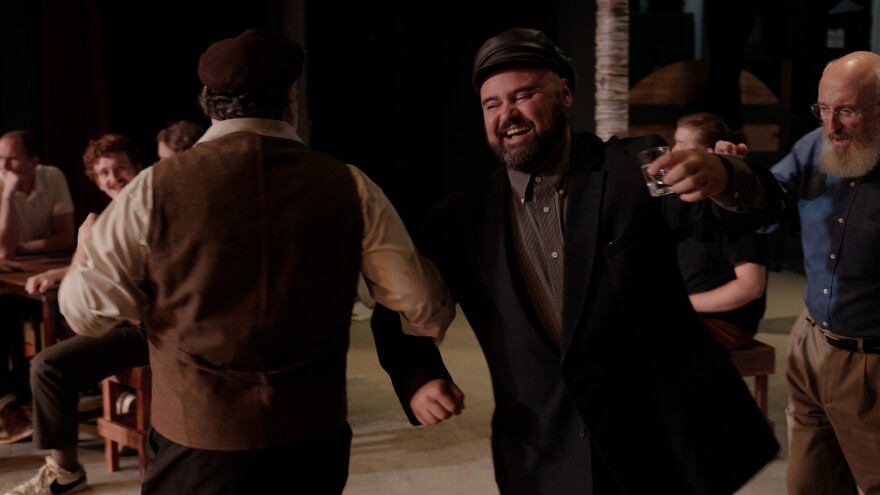Community Players Theatre is back on stage next month with a new production of “Fiddler on the Roof.”
Premiering in 1964, the nine-time Tony Award-winning musical (with music by Jerry Bock, lyrics by Sheldon Harnick, book by Joseph Stein and direction and choreography by Jerome Robbins) tells the story of a fictional village called Anatevka, based after early 20th century Jewish settlements in Imperial Russia. The story centers on the town's milk man, Tevye, and his three oldest daughters: Tzeitel, Hodel and Chava.
As one of the few Jewish cast members, ensemble performer Morgan Rondinelli volunteered to be the production's dramaturg. In that role, she provides insight and context on Jewish vocabulary and customs present in the musical. A major theme is Tevye's commitment to tradition as his daughters are pulled toward the modern world.
“I view it as tiers of pushing tradition,” Rondinelli said. Much of that pushback surrounds the custom of arranged marriages. Tzeitel, the oldest daughter, has been promised to an influential middle-aged bachelor, but she wants to marry her best friend, Motel.
“She still asks for permission, and she wouldn’t do it if her dad didn’t say yes,” said Rondinelli. Hodel asks for a blessing, not permission, and Chava marries outside her faith and community. “I won’t give any spoilers, but it does not go well.”

Rondinelli said the simultaneous “urge and tension” toward tradition is something Jewish Americans struggle with, even today. In a group session gathering cast members with Rabbi Rebecca Dubowe and Alvin Goldfarb at Moses Montefiore Temple earlier this month, Goldfarb said that rub is about the desire for community.
“I can totally relate to that,” Rondinelli said. “We want to feel like we’re part of a group, but it also can be othering.”
Rondinelli grew up in a community with a handful of Jewish families. She had a bat mitzvah and took school days off to celebrate the high holidays that aren’t recognized by most schools.
“It’s confusing, because in a way it makes me who I am and it makes me special to be different,” she said. “But sometimes— like we’re getting to December — it really does make you feel like the other. You want to be part of the broader group, and you are, but you’re not. I’m different, but I’m also just the same as everyone else.”
“Fiddler on the Roof” introduced millions of Americans to Jewish culture and is perceived as groundbreaking for its authenticity. (The previous decade brought “The King and I,” “West Side Story,” and “Gypsy,” for example.) Theatrical depictions of the sabbath and wedding ceremony gave people a bird's eye view of Ashkenazi homes, though certain terms have been anglified.
“There has been some critique that it’s not Jewish enough,” said Rondinelli. “Like, they call it the wedding canopy instead of a chuppah. Maybe that’s because the audience wouldn’t know what a chuppah is, but it’s pretty easy to tell from context what they’re talking about. They call it a head covering. Why not call it a yarmulke? Most people know what that is.”
Still, “Fiddler on the Roof” presents a concept Rondinelli said is at the core of Judaism: questioning.
“These rules aren’t literal,” she said. “I get to question these things continually. I think that’s true in Anatevka, too. Each of the daughters is questioning the rules, pushing it a little further and trying to figure out where they fit in Anatevka and the world.”
The Anatevka of “Fiddler on the Roof” is a fictional place. But Anatevka is also real. A refugee settlement formed outside Kyiv in 2015 provided food, housing and medical support to Ukrainian refugees fleeing Donbas. They named it Anatevka. The village has become a headquarters for humanitarian efforts following the 2022 Russian invasion, giving many refugees aid on their way to Moldova.
In an instance of art-imitating-life, the families of fictional Anatevka must make hard decisions about whether to stay or leave their home amid political and religious tension in Russian-occupied Ukraine. Coincidentally, members of Community Players Theatre were rehearsing as news broke of Hamas’ unexpected strike on Israel, forcing many to flee their homes.
“Tevye has this line toward the end where he says, ‘Maybe that’s why we always wear our hats,’" Rondinelli said. "Of course, that’s not why we wear yarmulkes, but it’s smart. You’re ready to go. Education is of utmost importance. People can take your house but they can’t take your degrees. That’s just something that’s in our bones. It’s deep in the culture.”
“Fiddler on the Roof runs Nov. 3-19 with a pay-what-you-can preview on Nov. 2 at Community Players Theatre, 201 Robinhood Lane, Bloomington. Tickets $10-$20 at 309-663-2121 and communityplayers.org.



